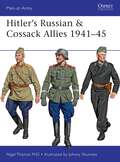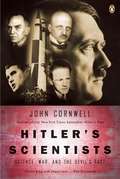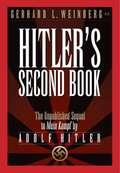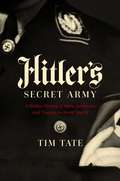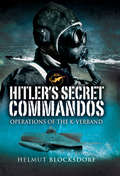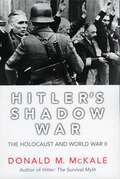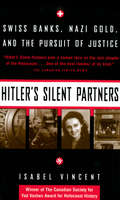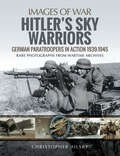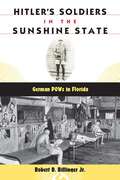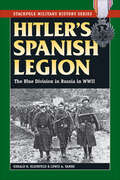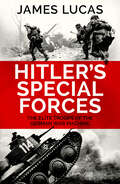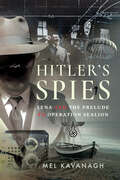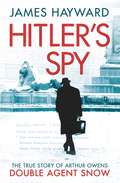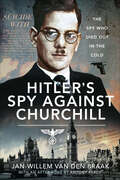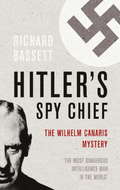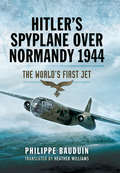- Table View
- List View
Hitler's Russian & Cossack Allies 1941-45
by Johnny Shumate Nigel ThomasGiven the merciless way in which the war on the Eastern Front of World War II was conducted, it is difficult to imagine soldiers changing allegiance from one side to another. Yet after the German invasion of Russia in Operation Barbarossa, well over 400,000 former Soviet Citizens went on to fight for Nazi Germany in some capacity. These included not only the 'legions' recruited from non-Russian ethnic groups eager for freedom from Stalin's dictatorship, but also some 100,000 Russians and Cossacks. What began as small local security units of 'Ostruppen', enrolled for the ongoing campaigns against Soviet partisans, were later reorganized, given special systems of uniform and insignia, amalgamated into larger formations, and eventually committed to the front line. This book offers up an essential guide to the appearance, formation and equipment of the myriad Russian and Soviet units that fought for the Germans. It uses rare photographs and revealing color illustrations to create a peerless visual reference to the troops who switched from one ruthless superpower to another and met with a horrific fate when the fighting was over.
Hitler's Scientists
by John CornwellAn eye-opening account of the rise of science in Germany through to Hitler's regime, and the frightening Nazi experiments that occurred during the ReichA shocking account of Nazi science, and a compelling look at the the dramatic rise of German science in the nineteenth century, its preeminence in the early twentieth, and the frightening developments that led to its collapse in 1945, this is the compelling story of German scientists under Hitler's regime. Weaving the history of science and technology with the fortunes of war and the stories of men and women whose discoveries brought both benefits and destruction to the world, Hitler's Scientists raises questions that are still urgent today. As science becomes embroiled in new generations of weapons of mass destruction and the war against terrorism, as advances in biotechnology outstrip traditional ethics, this powerful account of Nazi science forms a crucial commentary on the ethical role of science.
Hitler's Scientists: Science, War and the Devil's Pact
by John CornwellIn a rich and fascinating history John Cornwell tells the epic story of Germany's scientists from the First World War to the collapse of Hitler's Reich. He shows how Germany became the world's Mecca for inventive genius, taking the lion's share of Nobel awards, before Hitler's regime hijacked science for wars of conquest and genocidal racism. Cornwell gives a dramatic account of the wide ranging Nazi research projects, from rockets to nuclear weapons; the pursuit of advanced technology for irrational ends, concluding with with penetrating relevance for today: the inherent dangers of science without conscience.
Hitler's Second Book
by Gerhard L. Weinberg"Provides a valuable insight into the development of ideas that were to shape Hitler's foreign policy after 1933."-Jeremy Noakes, The Times Literary Supplement"The text bears all of Hitler's hallmarks, along with a terrifying, sustained belief in war and violence as a means to ensure that Germany would flourish."-Publishers Weekly"He envisaged the German people becoming involved in a series of wars for Lebensraum culminating in an epic battle against America."-Michael Smith, Daily Telegraph"The Second Book is in many ways more important than Mein Kampf."-Guardian"I have never known anyone to say this is a forged document."-Volker Berghahn, The New York Times"Hitler admires the 'young, racially select' American people and the nation's restrictive immigration policies at the time."-The New York Times"Far more than Mein Kampf, the Second Book establishes the grandiose scale of Hitler's ambitions."-Dennis Showalter, Colorado College"More clearly than ever, Hitler sketched out the worldwide struggle against the Jews which he and his party had to lead."-Richard Overy, GuardianHitler's Second Book is the first complete and annotated edition of the manuscript Hitler dictated shortly before his rise to power four year after publishing Mein Kampf. It contains a catalog of shocking policy statements and previously undisclosed plans of world conquest at the core of Nazi ideology that Hitler concluded were too provocative for publication.
Hitler's Secret
by Will Osborne William Osborne"An incredible adventure and a great page-turner!" -- Bear GryllsOtto and Leni thought they were safe: They escaped -- barely -- from war-torn Europe and are living as refugees in England. But now the Crown has recruited them: Great Britian wants them to go back. As spies!Dropped behind enemy lines, they embark on a top-secret operation. Code name: Wolfsangel. Their mission? Capture the one person who can defeat the ultimate evil of Nazism! Der Fuhrer has destroyed Otto's and Leni's families, but what if the tables were turned? What if Hitler's ultimate legacy was in their hands?Breathless pacing, nonstop action: By the screenwriter of Goldeneye, HITLER'S SECRET is a cinematic tale of revenge with an unexpected twist. A note by the author explains the truth behind the fiction and lets readers know what really became of history's greatest villains.
Hitler's Secret Army: A Hidden History Of Spies, Saboteurs, And Traitors
by Tim TateThis dramatic exposé of Allied subterfuge and betrayal uncovers the treachery of undercover fascists and American Nazi spy rings during the height of World War II. Between 1939 and 1945, more than seventy Allied men and women were convicted—mostly in secret trials—of working to help Nazi Germany win the war. In the same period, hundreds of British Fascists were also interned without trial on specific and detailed evidence that they were spying for, or working on behalf of, Germany. Collectively, these men and women were part of a little-known Fifth Column: traitors who committed crimes including espionage, sabotage, communicating with enemy intelligence agents and attempting to cause disaffection amongst Allied troops. Four of these traitors were sentenced to death; two were executed, whilst most of the others received lengthy prison sentences or were interned throughout the war. Hundreds of official files, released piecemeal and in remarkably haphazard fashion in the years between 2002 and 2017, reveal the truth about the Allied men and women who formed these spy rings. Most were ardent fascists: all willingly betrayed their own country in the hope and anticipation of a German victory. Several were part of international espionage rings based in the United States. If these men and women were, for the most part, lone wolves or members of small networks, others were much more dangerous. In 1940, during some of the darkest days of the war, two well-connected British Nazi sympathizers planned overlapping conspiracies to bring about a “fascist revolution.” These plots were foiled by Allied spymasters through radical—and often contentious—methods of investigation. Its agents set up elaborate agent provocateur and sting operations which uncovered scores of the Nazi sympathizers seeking to pass military and defense secrets to the enemy.
Hitler's Secret Commandos: Operations of the K-Verband
by Helmut BlocksdorfAn extensive history of the amphibious attack unit created by Nazi Germany during World War II.Hitler&’s Secret Commandos is the history of the K-Verband naval commando unit, established in 1943 to wreak havoc amongst invading allied forces involved in amphibious landings or actions, against German-occupied coasts. Following the Italian and British example, the basic idea was for a small, exceptionally well-trained and reliable commando force using the maximum element of surprise. Midget U-boats and small torpedo-carrying craft along the lines of the &“explosive boats&” used by the Italian Navy were designed for individual operations while a naval assault troop was formed for missions against important enemy operational targets near the sea after being landed from naval vessels offshore. Using German archive material, first-hand accounts and other published material this is the first comprehensive history of the K-Verband. It charts the development, structure, selection, training and equipment the Commando unit used together with a detailed narrative of the operations undertaken. The material has been translated from a German text, previously published in Germany with wide acclaim.
Hitler's Secret Jewish Psychic: And Other Strange and Obscure History
by Phil MasonA treasure trove filled with fascinating anecdotes about the tiny ripples that have caused big waves in history, Hitler's Secret Jewish Psychic will cure you of two misconceptions: the first being that history is relentlessly boring and the second that significant historical events are caused by significant and great causes.Here you'll unearth a multitude of facts you never knew were true. You'll learn some unbelievable things about some of the most prominent figures in history (Picasso was stillborn until his uncle revived him by blowing cigar smoke in his face!). You'll discover facts about some of the most famous wars in history (Japan actually manufactured balloons carrying deadly diseases, which they attempted to send over the Pacific Ocean to the United States). Other strange facts include:The career Fidel Castro almost chose over his leadership of CubaWhere Eli Whitney got the idea for his invention of the cotton ginWhat almost happened during the Wrights brothers' first successful flightWhy certain literary works almost never saw the light of publicationWhat day should have really been designated Independence DayThe truth behind Winston Churchill's daring escape from a Boer War prisoner-of-war campFranklin Roosevelt's campaign cover-upThe behind-the-scene beliefs of Isaac NewtonAnd many more!It is true that many things you hear should be taken with a pinch of salt; nothing proves this so much as Hitler's Secret Jewish Psychic, where you will discover the outrageous secrets history has tried (and failed) to keep.
Hitler's Secret War in South America, 1939--1945: German Military Espionage and Allied Counterespionage in Brazil
by Stanley E. HiltonPublished first in Brazil as Suástica sobre o Brasil, this examination of the rise and fall of German espionage in that country spent months on the best-seller list there and generated a national furor as former spies and collaborationists denounced it as a CIA ploy. Here, for the first time, are the colorful stories of such German agents as "Alfredo," probably the most important enemy operative in the Americas; "King," who was decorated for his daring exploits but who carelessly mentioned the real names of his collaborators in secret radio messages; the bumbling Janos Salamon; and the debonair Hans Christian von Kotze, who ultimately betrayed the Abwehr (German Military Intelligence).Eminently readable, Hitler's Secret War in South America resembles, but is not, fiction. It describes in detail the Allies' real battle against the Abwehr, a struggle highlighted by the interception and deciphering of German radio transmissions.
Hitler's Shadow Empire: Nazi Economics and the Spanish Civil War
by Pierpaolo BarbieriA revealing look at Nazi involvement in the Spanish Civil War, their economic ambitions, how it came to be, and how they operated.Pitting fascists and communists in a showdown for supremacy, the Spanish Civil War has long been seen as a grim dress rehearsal for World War II. Francisco Franco’s Nationalists prevailed with German and Italian military assistance—a clear instance, it seemed, of like-minded regimes joining forces in the fight against global Bolshevism. In Hitler’s Shadow Empire Pierpaolo Barbieri revises this standard account of Axis intervention in the Spanish Civil War, arguing that economic ambitions—not ideology—drove Hitler’s Iberian intervention. The Nazis hoped to establish an economic empire in Europe, and in Spain they tested the tactics intended for future subject territories.The Nazis provided Franco’s Nationalists with planes, armaments, and tanks, but behind this largesse was a Faustian bargain. Through weapons and material support, Germany gradually absorbed Spain into an informal empire, extending control over key Spanish resources in order to fuel its own burgeoning war industries. This plan was only possible and profitable because of Hitler’s economic czar, Hjalmar Schacht, a “wizard of international finance.” His policies fostered the interwar German recovery and consolidated Hitler’s dictatorship. Though Schacht’s economic strategy was eventually abandoned in favor of a very different conception of racial empire, Barbieri argues it was in many ways a more effective strategic option for the Third Reich.Deepening our understanding of the Spanish Civil War by placing it in the context of Nazi imperial ambitions, Hitler’s Shadow Empire illuminates a fratricidal tragedy that still reverberates in Spanish life as well as the world war it heralded.Praise for Hitler’s Shadow Empire“A fascinating, beautifully written account of a plan for the German economic domination of Europe that was pushed in the 1930s by the Nazis but above all by non-Nazi and more traditionally oriented German economic bureaucrats. Barbieri makes us think again about the relationship between economics and racial policies in the making of Nazi aggression.” —Harold James, author of Making the European Monetary Union“Hitler’s Shadow Empire recasts our understanding of the German and Italian interventions in the Spanish Civil War. In this brilliant debut, Barbieri shows that informal imperialism played a more important part than fascist ideology in the way that Berlin looked at the conflict. Barbieri also has a keen ear for the continuing echoes of the Civil War for Spain—and indeed for Europe—today.” —Niall Ferguson, author of The Ascent of Money
Hitler's Shadow War: The Holocaust and World War II
by Donald M. McKaleIn Hitler's Shadow War, World War II scholar Donald M. McKale contends that the persecution and murder of the Jews, Slavs, and other groups was Hitler's primary effort during the war, not the conquest of Europe. According to McKale, Hitler and the Nazi leadership used the military campaigns of the war as a cover for a genocidal program that centered on the Final Solution. Hitler continued to commit extensive manpower and materials to this "shadow war" even when Germany was losing the battles of the war's closing years.
Hitler's Silent Partners: Swiss Banks, Nazi Gold, and the Pursuit of Justice
by Isabel VincentAward-winning journalist Isabel Vincent unravels the labyrinthine story behind the headlines by taking us through the life of survivor Renée Appel, who found refuge in Canada. With her, we come to understand what it means to wait for justice: how, on the eve of war, desperate men and women entrusted their life savings to Swiss banks; how Nazis laundered gold looted from Jewish families; how the demands of international business, Swiss bank secrecy, and greed kept the truth hidden for over half a century and still prevent restitution from being made. Hitler's Silent Partners is a rigorous and often heartbreaking look at statistics seldom given a human face.From the Trade Paperback edition.
Hitler's Sky Warriors: German Paratroopers in Action 1939–1945 (Images of War)
by Christopher AilsbyDuring the Second World War, the German Fallschirmjger (paratroopers) carried out many successful and daring operations, such as the capture of the Belgian fortress at Eben Emael in 1940 and the invasion of Crete in 1941. Hitler's Sky Warriors is a detailed examination of all the battles and campaigns of the Third Reich's airborne forces, illustrated throughout by many previously unpublished photographs. Hitler's Sky Warriors includes detailed accounts of all the ground campaigns of the parachute divisions, especially in Italy, where their epic defenses of Monte Cassino entered military legend. As well as being a comprehensive account of Fallschirmjger battles and campaigns, Hitler's Sky Warriors includes information on the specialist weapons and equipment developed for Germany's airborne forces. These include the paratrooper helmet, the FG 42 automatic rifle, the so-called 'gravity knife', the different jump smocks, parachutes and harnesses, transport aircraft and gliders. Hitler's Sky Warriors also contains biographical details on all the main parachute commanders, such as Kurt Student, Bernhard Herman Ramcke and Richard Heidrich, and includes appendices that contain information about divisional orders of battle and Knight's Cross winners. In this way Hitler's Sky Warriors builds into an extensive and exciting account of one of the elite formations of military history.
Hitler's Social Revolution: Class and Status in Nazi Germany 1933-1939
by David SchoenbaumBeginning with Germany's social situation after World War I, David Schoenbaum shows how Hitler improvised a program that apparently offered something to everyone--above all, the mirage of a classless society. In fact, the gap between the ideology of the Reich and its actual character was enormous. But under the spell of the mirage, the will to resist was undermined by an accelerating process of social disintegration.
Hitler's Soldiers in the Sunshine State: German POWs in Florida (Florida History and Culture)
by Robert D. Billinger Jr."They were Uncle Sam's smiling workers and they looked like all-American boys. There were at least 10,000 of them, deployed in 25 Florida camps between 1942 and 1946. They were also members of the Wehrmacht, Hitler's armed forces."--Forum"Most Americans were unaware their government was housing Hitler's soldiers on its shores. . . . Billinger weaves interviews with former prisoners, American soldiers who worked in the camps, newspaper accounts, and government documents into a stunning historical narrative."--Kansas City Star"A tropical paradise that for some became a tropical hell."--Sarasota Herald-Tribune"First came crewmen of destroyed U-boats, then thousands of Afrika Korps veterans who swamped the system in 1943. Pro-Nazi, arrogant, and tough, they defied U.S. authorities, terrorized anti-Nazi inmates, and rioted."--Choice"Filled with colorful personal accounts, this historical book packs the punch of fiction."--St. Petersburg Times"Billinger's first-rate history of this little-known chapter in American history teaches us that, in spite of wartime propaganda, our enemies are human, too."--Atlantic City Press"Hard to put down."--Daytona Beach News-Journal In the first book-length treatment of the German prisoner of war experience in Florida during World War II, Robert D. Billinger, Jr., tells the story of the 10,000 men who were "guests" of Uncle Sam in a tropical paradise that for some became a tropical hell. Having been captured while serving on U-boats off the Carolinas, with the Afrika Korps in Tunisia, with the paratroops in Italy, or with labor battalions in France, the POWs were among the 378,000 Germans held as prisoners in 45 states. Except for the servicemen who guarded them, the civilian pulp-cutters, citrus growers, and sugarcane foremen who worked them, and the FBI and local police who tracked the escapees among them, most people were--and still are--unaware of the German POWs who inhabited the 27 camps that dotted the Sunshine State. Billinger describes the experiences of the Germans and their captors as both sides came to the realization that, while the Germans’ worst enemies were often their own comrades-in-arms, wartime enemies might also become life-long friends. Concentrating especially on the story of Camp Blanding in North Florida, Billinger based his research on both American and German archives. His account mixes rare photos with interviews with former prisoners; reports by the International Red Cross, the YMCA, and the U.S. military; and local newspaper articles. This book will be of great value to scholars and historians, as well as all readers with an interest in World War II. Those with an interest in Florida history will also find much to admire in this engaging account of a barely known wartime episode.A volume in The Florida History and Culture Series, edited by Raymond Arsenault and Gary R. Mormino.
Hitler's Soldiers: The German Army in the Third Reich
by Ben H. ShepherdFor decades after 1945, it was generally believed that the German army, professional and morally decent, had largely stood apart from the SS, Gestapo, and other corps of the Nazi machine. Ben Shepherd draws on a wealth of primary sources and recent scholarship to convey a much darker, more complex picture. For the first time, the German army is examined throughout the Second World War, across all combat theaters and occupied regions, and from multiple perspectives: its battle performance, social composition, relationship with the Nazi state, and involvement in war crimes and military occupation. This was a true people's army, drawn from across German society and reflecting that society as it existed under the Nazis. Without the army and its conquests abroad, Shepherd explains, the Nazi regime could not have perpetrated its crimes against Jews, prisoners of war, and civilians in occupied countries. The author examines how the army was complicit in these crimes and why some soldiers, units, and higher commands were more complicit than others. Shepherd also reveals the reasons for the army's early battlefield successes and its mounting defeats up to 1945, the latter due not only to Allied superiority and Hitler's mismanagement as commander-in-chief, but also to the failings--moral, political, economic, strategic, and operational--of the army's own leadership.
Hitler's Spanish Legion: The Blue Division in Russia in WWII (Stackpole Military History Series)
by Gerald R KleinfeldA history of the 47,000 Spanish soldiers who volunteered to fight for Hitler in Russia during World War II. Although Spain claimed neutrality during World War II, 47,000 Spaniards volunteered to fight on behalf of the Third Reich. Known as the Blue Division, they battled the Soviets on the Eastern Front and played a key role in the pivotal siege of Leningrad. Set apart from the Wehrmacht by stark differences in culture, tactics, and command structure, these volunteers fought—many of them to the death—with courage and tenacity against strong opposition, extreme temperatures, and insufficient supplies for what they believed was their chance to secure Spain&’s place in a new and changing Europe.
Hitler's Special Forces: The elite troops of the German war machine
by James LucasBlood, fire and iron: An unforgettable portrait of the most feared soldiers of World War Two In the closing years of the 1930s, German agent-provocateurs worked in secrecy. These crack units of elite soldiers paved the way for the invasions of Czechoslovakia and Poland, the spark that would ignite a war across Europe. In time, they would go on to shape the conflict with terrifying ferocity and skill. The mysteries of German special forces are revealed here, with incisive analysis of naval, military and aerial operations, and vivid descriptions of suicide pilots, human torpedoes and explosive motor boats. James Lucas delivers one of the fullest and most accessible ever accounts of the elite troops known as Kommandos, across both their achievements and failures to stave off impending military defeat. This is war at its toughest, most harrowing and most extreme.
Hitler's Spies: Lena and the Prelude to Operation Sealion
by Mel KavanaghThe incredible true story of the first four Nazi spies to infiltrate British soil is revealed in this WWII history.After the swift takeover of France and the Low Countries, Nazi Germany was on the crest of a wave. Only the United Kingdom stood in its way. Hitler quickly devised plans for the invasion of England, codenamed Operation Sealion. To lay the groundwork, a team of spies would be sent in advance to act as pathfinders for the incoming forces. Codenamed Operation Lena, this phase of the plan was considered a suicide mission by German military intelligence. They had only thirty days to recruit and train agents who had a less than convincing grasp of English language or customs. Hitler’s Spies revels the story of the first four agents to arrive on English soil—collectively known by MI5 as “The Brussels Four.”Using a wealth of primary materials, including newly declassified sources, Mel Kavanagh sheds light on one of the most audacious yet little-known operations of the Second World War, in which undertrained men were sent behind enemy lines at a time when Britain was gripped by spy paranoia.
Hitler's Spy
by James HaywardOriginally published as Double Agent Snow, Hitler's Spy is the paperback edition, which tells of how on the eve of the outbreak of the Second World War the double-agent Arthur Owens, codenamed SNOW, is summoned to Berlin and appointed Hitler's chief spy in Britain. Days later he finds himself in Wandsworth prison, betrayed by the wife he traded for a younger model, and forced to transmit false wireless messages for MI5 to earn his freedom - and avoid the hangman's noose. A vain and devious anti-hero with no moral compass, Owen's motives were status, money and women. He mixed fact with fiction constantly, and at times insisted that he was a true patriot, undertaking hazardous secret missions for his mother country; at other times, Owens saw himself as a daring rogue agent, outwitting British Intelligence and loyal only to the Fatherland. Yet in 1944, as Allied troops stormed the beaches of Normandy on D-Day, Hitler was caught unawares, tricked into expecting the invasion across the Pas de Calais in a strategic deception played out by Owens and the double-cross agents of MI5. For all his flaws, Agent Snow became the traitor who saved his country. Based on recently de-classified MI5 files and previously unpublished sources, Hitler's Spy is the story of a secret Battle of Britain, fought by Snow and his opposing spymasters, Thomas 'Tar' Robertson of MI5 and Nikolaus Ritter of the Abwehr, as well as the tragic love triangle between Owens, his wife Irene, and his mistress Lily Funnell. The evocative, fast-paced narrative moves from seedy south London pubs to North Sea trawlers, from chic Baltic spa resorts to Dartmoor gaol, populated by a colourful rogue's gallery of double-cross agents.
Hitler's Spy Against Churchill: The Spy Who Died Out in the Cold
by Jan-Willem van den BraakFrom the summer of 1940 until May 1941, nearly twenty German Abwehr agents were dropped by boat or parachute into England during what was known as Operation Lena, all in preparation for Hitler's planned invasion of England. The invasion itself would never happen and in fact, after the war, one of the Abwehr commanders declared that the operation was doomed to failure. There is no doubt that the operation did indeed become a fiasco, with almost all of the officers being arrested within a very brief period of time. Some of the men were executed, while others became double agents and spied for Britain against Germany. Only one man managed to stay at large for five months before eventually committing suicide: Jan Willem Ter Braak. Amazingly, his background and objectives had always remained unclear, and none of the other Lena spies had ever even heard of him. Even after the opening of the secret service files in England and the Netherlands over 50 years later, Jan Willem Ter Braak remained a 'mystery man', as the military historian Ladislas Farago famously described him. In this book, the author – his near-namesake – examines the short and tragic life of Jan Willem Ter Braak for the first time. Using in-depth research, he investigates the possibility that Ter Braak was sent to kill the British Prime Minister Winston Churchill and discovers why his fate has remained largely unknown for so long.
Hitler's Spy Chief: The Wilhelm Canaris Mystery
by Richard BassettA remarkable tale of espionage and intrigue--the true story of Wilhelm Canaris, Hitler's intelligence chief, and his role in the conspiracy to assassinate the Führer Admiral Wilhelm Canaris was appointed by Hitler to head the Abwehr (the German secret service) eighteen months after the Nazis came to power. But Canaris turned against the Fu¨hrer and the Nazi regime, believing that Hitler would start a war Germany could not win. In 1938 he was involved in an attempted coup, undermined by British Prime Minister Neville Chamberlain. In 1940 he sabotaged the German plan to invade England, and fed General Franco vital information that helped him keep Spain out of the war. For years he played a dangerous double game, desperately trying to keep one step ahead of the Gestapo. The SS chief, Heinrich Himmler, became suspicious of Canaris and by 1944, when Abwehr personnel were involved in the attempted assassination of Hitler, he had the evidence to arrest Canaris himself. Canaris was executed a few weeks before the end of the war. In a riveting true story of intrigue and espionage, Richard Bassett reveals how Admiral Canaris's secret work against the German leadership changed the course of World War II.
Hitler's Spy Chief: The Wilhelm Canaris Mystery
by Richard BassettHow Hitler's spy chief sabotaged the German war effort.Wilhelm Canaris was appointed by Hitler to head the Abwehr (the German secret service) 18 months after the Nazis came to power. But Canaris turned against the Fuhrer and the Nazi regime, believing that Hitler would start a war Germany could not win. In 1938 he was involved in an attempted coup, undermined by British Prime Minister Neville Chamberlain. In 1940 he sabotaged the German plan to invade England, and fed General Franco vital information that helped him keep Spain out of the war. For years he played a dangerous double game, desperately trying to keep one step ahead of the Gestapo. The SS chief, Heinrich Himmler, became suspicious of the Abwehr and by 1944, when Abwehr personnel were involved in the attempted assassination of Hitler, he had the evidence to arrest Canaris himself. Canaris was executed a few weeks before the end of the war.
Hitler's Spy Chief: The Wilhelm Canaris Mystery
by Richard BassettHow Hitler's spy chief sabotaged the German war effort.Wilhelm Canaris was appointed by Hitler to head the Abwehr (the German secret service) 18 months after the Nazis came to power. But Canaris turned against the Fuhrer and the Nazi regime, believing that Hitler would start a war Germany could not win. In 1938 he was involved in an attempted coup, undermined by British Prime Minister Neville Chamberlain. In 1940 he sabotaged the German plan to invade England, and fed General Franco vital information that helped him keep Spain out of the war. For years he played a dangerous double game, desperately trying to keep one step ahead of the Gestapo. The SS chief, Heinrich Himmler, became suspicious of the Abwehr and by 1944, when Abwehr personnel were involved in the attempted assassination of Hitler, he had the evidence to arrest Canaris himself. Canaris was executed a few weeks before the end of the war.
Hitler's Spyplane Over Normandy, 1944: The World's First Jet
by Philippe BauduinA pictorial history of the groundbreaking jet bomber known as the Arado 234, including never-before-seen archival photos. This is the story of the Arado 234, an aircraft that on one day in 1944, in the skies above Normandy, heralded the beginning of a new era in military aviation. Many individuals over many years have contributed to the field of developmental aviation. One of these key players is Heinrich Lubbe, a man who marked the evolution of aerial transportation through his cultivation of technological excellence. From flying lessons given to him by his friend Roland Garros, to the creation of the Arado business, Lubbe made a significant impact and left a lasting legacy. His machines were flown by exceptional pilots such as Horst Gotz and Erich Sommer, known as &“des moustachus&” (the moustachioed). In Hitler&’s Germany, the Arado jets were put to work in a variety of contexts. Perhaps most significantly, they were employed in the task of photo-reconnaissance during the Battle for Normandy, following the iconic landings of June 1944. In this role, they brought back extraordinary images from the invasion beaches, revealing with astounding detail the positions and plans of the Allied forces. These images, previously unseen by the public, shed new light on the battle, at the same time proving the Germans&’ indisputable superiority in the field of jet aviation. The fact that American troops hastened to transfer the Arado AR234 and Messerschmitt 262 to the USA to uncover all their secrets post-war says a lot about how they were viewed in the eyes of the enemy. In addition to many top-secret aerial images, this book is enriched with photographs from the personal archives of Erich Sommer, the Arado pilot, which have never before been published. Packed with both color and black and white images, this book and represents an impressive pictorial history of the world&’s first jet bomber.
